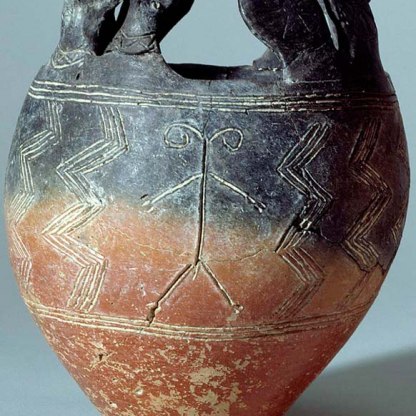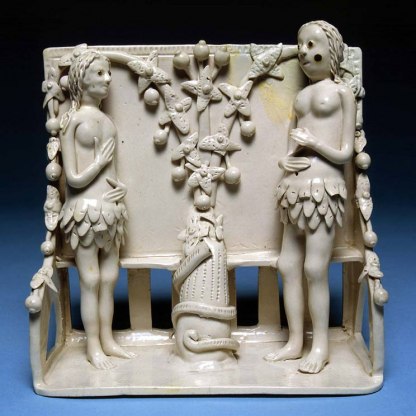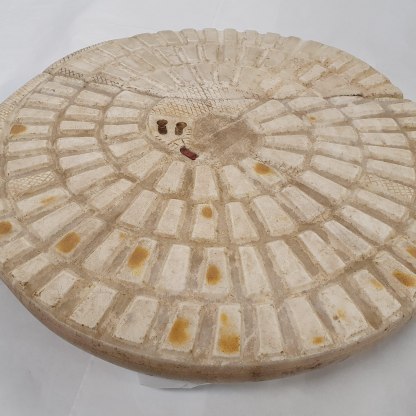Haniwa, a Female Figurine

This type of simple, unglazed, red clay figure is known as a haniwa. The word means literally ‘circle of clay,’ and this example is one of several that would have stood around, upon or within the tomb of an important individual who died during Japan’s Kofun Period, 250–552 CE.
The Kofun Period gets its name from the burial mounds in which the powerful leaders of the time – Japan’s first emperors – were buried. It was during this period that the various areas that today make up modern Japan were gradually united under central rule. The kofun were huge keyhole-shaped mounds of earth, often surrounded by a moat. Each enclosed a stone chamber in which was deposited a wooden or stone coffin. Some of these burial mounds are vast – that of the Emperor Nintoku, near Osaka, covers over eighty acres.
The numbers of haniwa figures around or upon any one tomb varied from a few dozen to a few thousand. Their exact meaning and function are unclear, and they come in several shapes and sizes. The earliest and commonest types are simple cylinders, while others were more elaborately modelled into animals, buildings, armour and other objects. They first appeared in human form between the fifth and seventh centuries. Haniwa figures and kofun tombs ceased to be used after Buddhism, with its quite different burial practices, became dominant in Japan in the seventh century.
A circle of haniwas may have served to separate the area of the tomb from the outside world, the world of the living, and may have been intended as servants for the deceased in the afterlife. It has been suggested that the tradition of placing them in a tomb might have derived from the Chinese practice of burying servants and goods with a dead ruler.
The more simple cylinders may have had the more prosaic function of stabilising the ground around the large mounds. Some were used to support the roof within the tomb.
If haniwas were indeed intended to protect the deceased magically, then the Fitzwilliam figure looks well suited to the task. It has been constructed from coils of clay that have been smoothed over, with added clay decorations: bracelets, necklace, and earrings. There are traces of paint on the simple but arresting face. The nose is merely a raised triangle. Three simple slits in the clay describe the eyes and mouth. The figure wears an expression of emotionless determination, and conveys a sense of quiet, uncompromising power.
The beguiling simplicity of haniwa figures seems to conform to the Japanese aesthetic of wabi sabi, defined as
'the beauty of things imperfect, impermanent and incomplete. It is a beauty of things modest and humble. It is a beauty of things unconventional.'
Themes and periods
Data from our collections database
Red earthenware, hand built, with traces of pigment. This fragment of a haniwa figure of a woman is made of coiled and smoothed clay with pierced slits for the eyes and mouth, and an applied clay nose, and jewellery. Remnants of the original colouring can be seen on her face.
Unknown before donor
Legal notes
Given by Mr and Mrs Conrad Abrahams-Curièl in memory of their daughter, Eleanora
Acquisition and important dates
- Method of acquisition: Given
- Dates: 1991
Dating
Maker(s)
- Unknown Maker
Place(s) associated
- Japan
Materials used in production
Read more about this recordOther highlight objects you might like
Suggested Curating Cambridge products
Sign up to our emails
Be the first to hear about our news, exhibitions, events and more…





